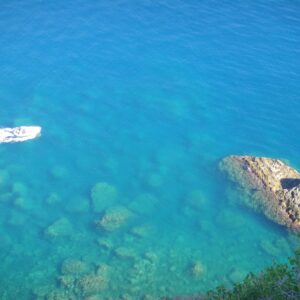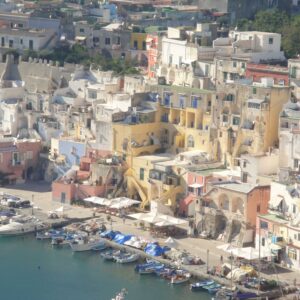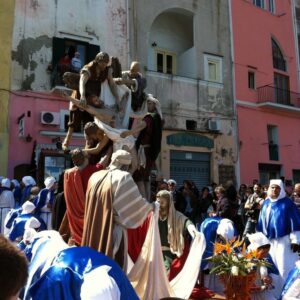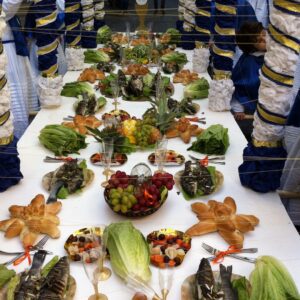On January 18, 2021 the Island of Procida was chosen to be the Italian Capital of Culture for 2022. This designation means that many projects will be undertaken to showcase and enhance its cultural heritage, aid territorial development, and improve services for international tourists.

You probably have never heard of the Island of Procida, which lies low in the Gulf of Naples. In fact, Pliny writes that the name Procida has a Greek origin meaning “stretched out or lying down.”
It is the smallest inhabited (pop. 10,600) island in the Gulf of Naples and, at only 4 sq km (1.6 sq. mi.) is 1/10 the size of its neighbor, Ischia. Its uninhabited baby sister, Vivara, is a miniscule 0.75 sq km. Procida and Vivara were born out of violent volcanic activity.

They were not originally islands but part of the mainland. Over time, some of the original craters were eroded by the sea, destroying the connection.
Archeologists tell us that Procida has been inhabited since the XVI century B.C. by settlers from the area of Mycenae in the Greek Peloponnese. In the VIII century B.C., it was a port used by the Euboeans who settled in Ischia and Cumae.
Recent archeological finds have provided scholars with a missing link in their reconstruction of the movements of XVII-XIV century B.C. Mediterranean voyagers.

In medieval times, the Fortified Village of Terra Murata was built to protect Procida from the Saracens. The dominant building there is the Palace of Avalos, built in the 15th century. In 1830 it was transformed into a prison, and definitively closed in 1988. It still dominates the landscape when approaching the island. The Abbey of St. Michael, which dates to the 16th century can also be visited.
The violent volcanic activity which gave birth to the island produced the marvelous bays and beaches we get to enjoy today. In fact, the landscape is so stunning that more than 30 movies have been shot there,
including scenes from Cleopatra in 1963, The Talented Mr. Ripley and Il Postino. In 2013 the Procida Film Festival was started, offering a competition open to young movie directors and writers.
The island was also the setting for Alphonse de Lamartine’s novel Graziella (1852) and Elsa Morante’s Arturo’s Island (1957). Each summer, a contest is held to elect a young woman as “Graziella”.
She wears the customary clothes of the island as set in Lamartine’s novel. There is also a literary prize given dedicated to Elsa Morante.
If you are lucky enough to be in the area at Easter, don’t miss one of the most sacred festivals in the area, the mysteries of the life of Christ on Good Friday. At dawn, men and boys, members of the Confraternity of the Turchini, (started by the Jesuits in 1629) assemble near handmade allegorical floats.
These have been designed and constructed by various neighborhood groups and are incredible works of art, depicting various mysteries and miracles. The floats are carried by Confraternity members wearing
the traditional white robe with azure blue mantle and hood called a “mozzetta”.

The only sound is the slow, ominous beat of the tympanum which portends the coming sacrifice Jesus will make.
The men struggle with the heavy floats yet demonstrate dignity and devotion in carrying out this sacred ritual.
The presentation of each miracle is much like a Cecil B. DeMille production. The scale and accuracy of many of these scenes, produced in papier mâché, wood, textiles and plants are only outdone by the real food used; evocative of bountiful Renaissance still life paintings.
In the parable of the loaves and fishes, real fish, probably caught that morning, are used. In fact, all scenes involving food, including the Last Supper, are a showcase for the bounty and beauty of the foodstuffs found locally.
This is a “not to be missed” event. The procession starts at 7:30 a.m. and runs about 3 hours. You might also want to go the day before, as the Holy Thursday pageant includes the procession of the 12 apostles and the ceremonial washing of the feet.

The island retains a charm of a bygone era as it still values artisans. Ceramics and paintings are for sale by local artists in the small shops that dot the island. Churches, painted in pastel colors, situated in dramatic locations, can be visited for a look at stunning island architecture.
In the summertime, the waters around the island are filled with swimmers and boaters. This magnificent landscape offers not only sandy beaches but a safe harbor for the fishing boats of Marina Corricella. The protected coves all over the island, with their tranquil waters, offer visitors secluded, pristine areas for outdoor enjoyment.
Procida and Vivara are part of a sanctuary which protects marine life. It is not unusual to see dolphins and even whales in these crystalline waters. Even though as late as the Roman era Vivara was once attached to Procida,
this comma shaped island is actually the western margin of a crater, the remainder of which is submerged. In 1957 the two islands were joined again.
This time by a causeway carrying the pipeline which brings water to the islands. It was the first underwater aqueduct in Europe. Today, Vivara is an uninhabited nature reserve which can be visited.
Reservations can be made with the Comune di Procida 081-810-9259 or check the website.
Let’s not forget about food! To accompany the fine, fresh, fish Procida is home to a unique dish of lemon salad.
The Procida lemons are called “limoni pane” or bread lemons because of their abundant pith.
They are also sweeter than a regular lemon. Because of this, they have been inserted into the list of typical foods from the Campania region.
For a small island, Procida delivers big cultural, culinary and recreational experiences.









